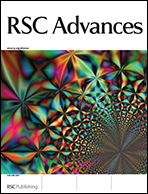Synthesis and structural characterization of new ruthenium(ii) complexes and investigation of their antiproliferative and metastatic effect against human lung cancer (A549) cells†
Abstract
Reaction of 2-hydroxy-1-naphthaldehyde-4(N)-ethylthiosemicarbazone [H2-(Nap-etsc)] with [RuHCl(CO)(PPh3)3] conferred two entities, namely [Ru(H-Nap-etsc)Cl(CO)(PPh3)2] (1) and [Ru(Nap-etsc)(CO)(PPh3)2]·Cl (2). The new complexes were characterized using various spectroanalytical and X-ray crystallographic techniques. In this reaction the dual coordination behaviour (thiolate/thione) of the ligand was observed. It acted as NS bidentate monobasic and ONS tridentate monobasic in entities 1 and 2 respectively. The binding ability of complexes (1 and 2) to calf thymus DNA (CT DNA)/BSA has been explored by absorption and emission titration methods. The cytotoxic nature of the complexes was evaluated on human lung cancer cells, A549. Complexes induced apoptotic cell death via ROS hypergeneration and mitochondrial membrane damage. In addition these newly synthesized ruthenium complexes inhibited A549 cell migration, as evidenced by wound healing assay. The activity of the complexes was found to be very high by comparing with cisplatin, a conventional standard. The time dependent release of the complexes from porous system was investigated by taking mesoporous silica as the host material. It was shown that the main portion of the embedded complexes was released after 20 h and reached a maximum after 96 h.


 Please wait while we load your content...
Please wait while we load your content...